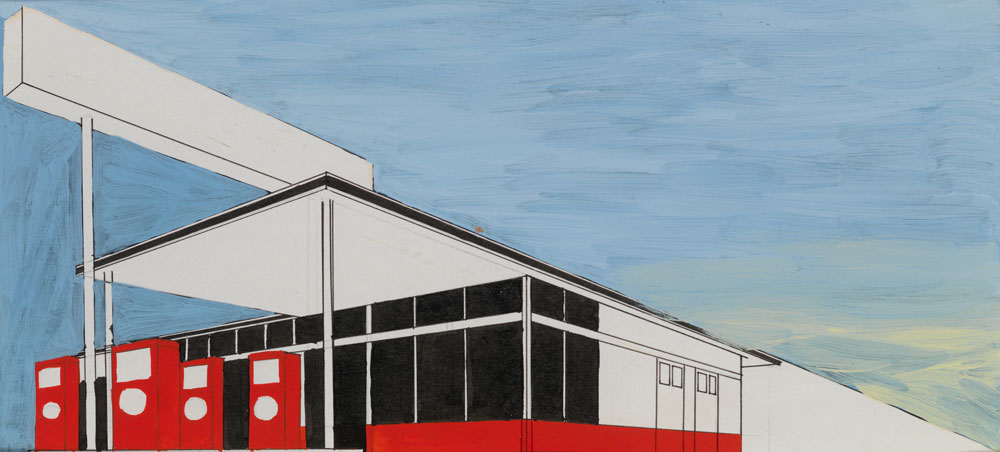
Scottish National Gallery of Modern Art, Edinburgh
29 April 2017 – 29 April 2018
by CHRISTIANA SPENS
From parking lots to swimming pools, from slogans to sidewalks, the American artist Ed Ruscha (b1937, Nebraska) captures the oddness and dissonance of the everyday, and the artificiality of the city that constructed Hollywood. While small in size, the Artists’ Rooms exhibition of Ruscha’s work at the Scottish National Gallery of Modern Art gives a great overview – including various media and phases of his career.
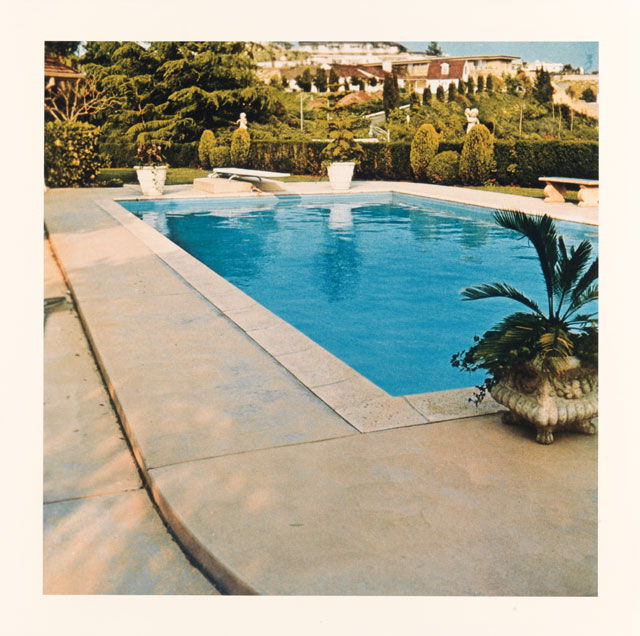
Ed Ruscha. Pool #1, 1968 / 1997. Colour photograph, 39.4 x 39.4 cm. Collection: Scottish National Gallery of Modern Art. Artist Rooms National Galleries of Scotland and Tate. Lent by the Artist Rooms Foundation 2011. © Ed Ruscha.
Entering the first room, what is most striking is the layout of two sets of photographs: six black-and-white images of a car lot (all from different angles), positioned next to nine shots of a turquoise swimming pool (also from various angles). Both sets give the impression of being almost voyeuristic, seeming to be stills from CCTV, although of better quality. There are no people in frame, and the stillness of the pool, especially, is eerie and unnerving.
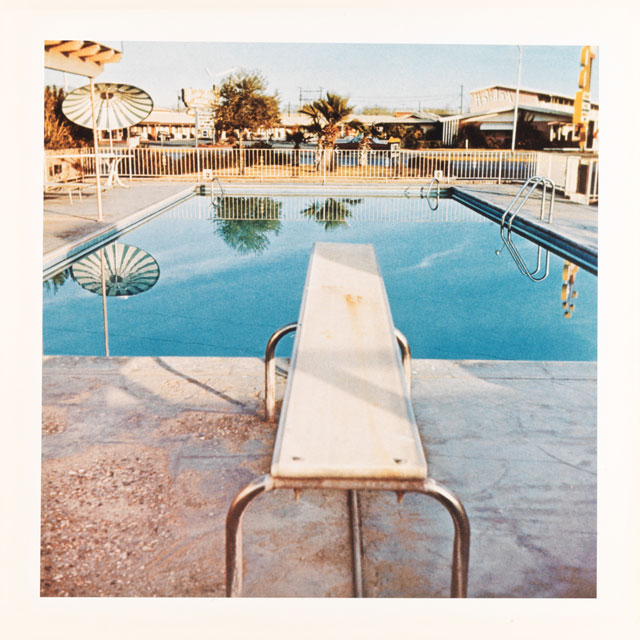
Ed Ruscha. Pool #2, 1968 / 1997. Colour photograph, 39.4 x 39.4 cm. Collection: Scottish National Gallery of Modern Art. Artist Rooms National Galleries of Scotland and Tate. Lent by the Artist Rooms Foundation 2011. © Ed Ruscha.
Ruscha takes his inspiration from surrealism and dadaism, explaining his choice of subject matter thus: “The photograph is just a surrogate gas station. The photograph itself doesn’t mean anything to me; it’s the gas station that’s the important thing.” Therein, he considers his photographs to be “a collection of readymades,” in the tradition of Marcel Duchamp. The photographs are not meant to look like fine art photography, as such, but are lifted straight from “real life” – from estate agents’ windows and surveillance cameras. Although reality TV had not yet been invented when Ruscha put these works together, its beginnings seem evident here. Ruscha, and the pop art movement he was peripherally involved in, clearly anticipated it many decades ago, and captured the disassociated oddness of being consumed by it.
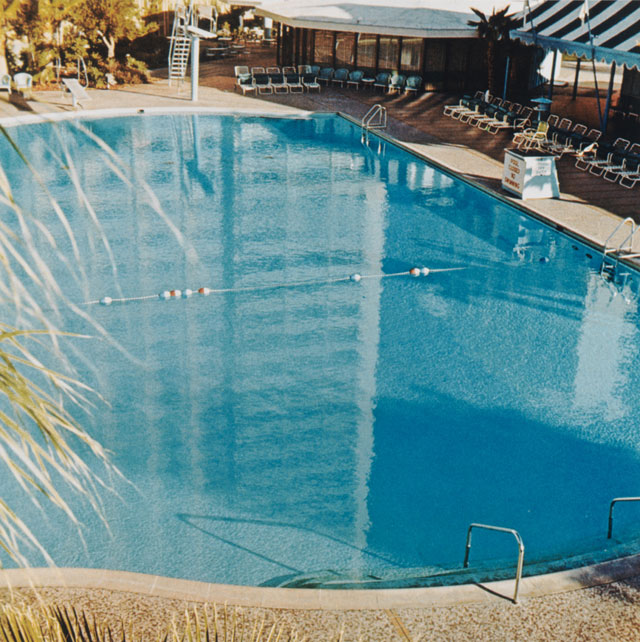
Ed Ruscha. Pool #8, 1968 / 1997. Colour photograph, 39.4 x 39.4 cm. Collection: Scottish National Gallery of Modern Art. Artist Rooms National Galleries of Scotland and Tate. Lent by the Artist Rooms Foundation 2011. © Ed Ruscha.
The prominence of these photographs as forms of “found objects” frames the rest of the exhibition successfully; the forthcoming paintings and larger-scale works emerge as an extension of that conceptual, surrealist take on the city. A sense of the uncanny also appears in the voyeuristic angles and subtle compositional discord. An eeriness therefore lingers in the atmosphere of the exhibition, with its associations with JG Ballard, David Lynch, surveillance, and even Lana Del Rey. This is a city, Ruscha’s photographs and paintings seem to say, where bad things happen, and where secrets are kept. The bleached tones and bright lights give the impression of concealment; the surfaces are too clean to be real, and the scenes too empty to be lifelike. This Hollywood is so reduced and abstracted that a sense of death permeates, in the two-dimensional, impossible landscapes and the sidewalks without footprints.
Ruscha pays homage to JG Ballard in particular, quoting from his novel High-Rise (1975) in the largescale work, The Music from the Balconies (1984). In Ballard’s dystopian novel, the inhabitants of a high-rise apartment block descend into chaos and primal urges, communicating a rather bleak vision of human nature. In Ruscha’s painting, a quote from High-Rise overlays an otherwise serene landscape, creating discord in that act itself, and so reinforcing the meaning of the words: “The music from the balconies nearby was overlaid by the noise of sporadic acts of violence.” With this careful, deadpanexecution, Ruscha’s work also recalls the writing of Bret Easton Ellis, particularly his Los Angeles-based debut Less Than Zero,which was written at around the same time this work was created and was itself inspired by Andy Warhol’s experimental 1968 novel A: A Novel. Both Ruscha and Ellis, in the tradition of Ballard and Warhol, seem to have captured a similar atmosphere, and zeitgeist even, in their observations of LA in the mid-80s.
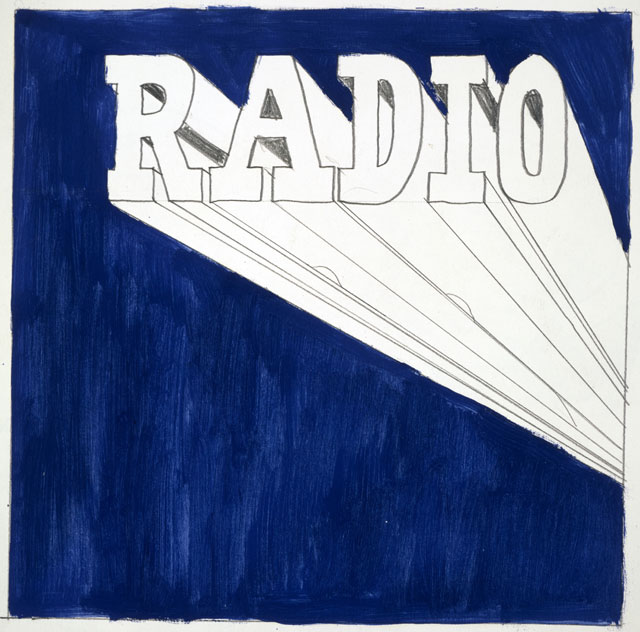
Ed Ruscha. Radio, 1962. Drawing, pencil and acrylic on paper, 24 x 27.2 cm. Collection: Scottish National Gallery of Modern Art, presented by the artist through the Art Fund, 2005. © Ed Ruscha.
The rest of Ruscha’s work on show in this exhibition carries on this atmosphere, and its thematic concern, in a way that is coherent and concise and, indeed, suits those qualities in the work itself. A clean, crisp and yet melancholy comment on the city, each carefully selected and curated work adds further to this vision.
In The End #40 (2003), for instance, these familiar words (marking the end of a film) are given more weight than usual, signifying mortality and the difficulty in truly believing in death when it is played out in films repetitively. It draws attention to the construct of narrative in film, and the comfort audiences derive from completion, which is at odds with our fear of death. This gloomy deconstruction dismantles the “Hollywood Ending” in a way that is both subtle and inescapable.
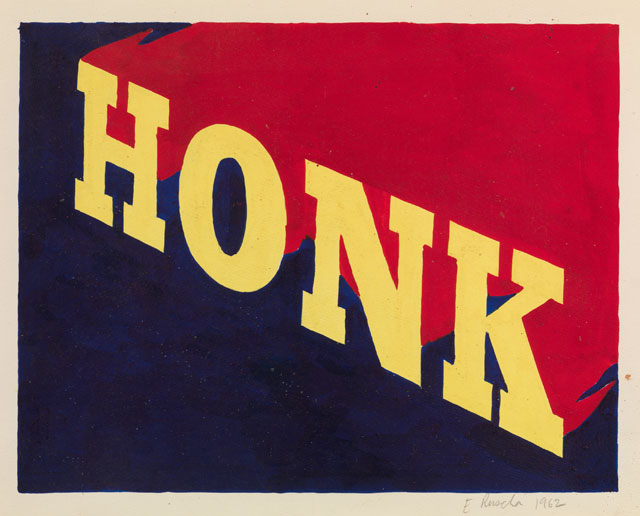
Ed Ruscha. HONK, 1962. Drawing, acrylic paint on paper, 27.9 x 35.2 cm. Collection: Scottish National Gallery of Modern Art. Artist Rooms National Galleries of Scotland and Tate. Acquired jointly through The d'Offay Donation with assistance from the National Heritage Memorial Fund and the Art Fund 2008. © Ed Ruscha.
In every other work, the American dream, and the city of its production, is illuminated as hollow and even facile. In Pretty Eyes, Electric Bills (1976), I Plead Insanity Because I’m Just Crazy About That Little Girl (1976) and Pay Nothing Until April (2003), for example, phrases taken from the everyday and pop culture become uncomfortable and disarming. Due to the unusual focus and combinations, combined with backgrounds of cheerful pastel colours and landscapes, the idea that the vapid belies the sinister is reinforced again – communicating an eeriness particular to this vision of Hollywood and the reality it conceals.
For all of this melancholic observation, however, Ruscha’s work is a joy to behold. Perhaps seeing the husks of dreams becomes somehow romantic, despite their impossibility and oddness; perhaps Ruscha’s vision itself – his reorganisation of the detritus of Los Angeles as something intelligent and funny – is enough to transform his bleak subject matter into something beautiful.